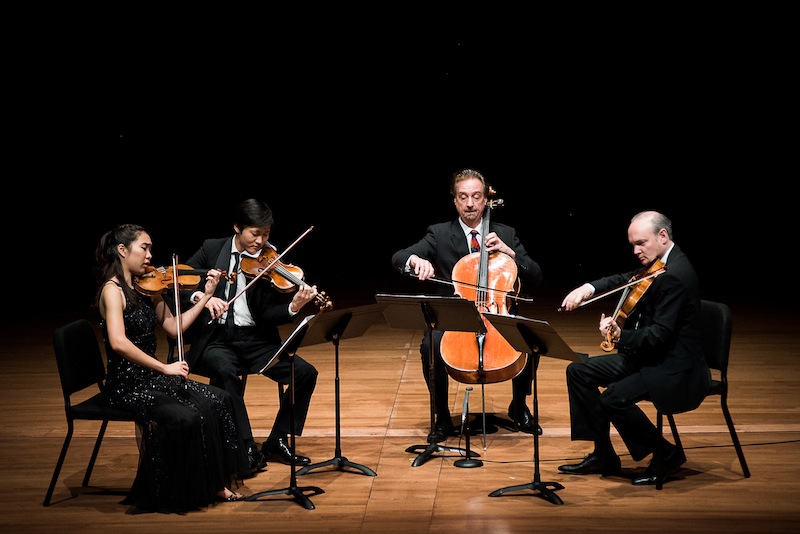Chamber Music Society unearths gems of Ysaÿe and Kreisler

Violinists Danbi Um and Sean Lee, cellist David Finckel, and violist Paul Neubauer performed music of Borodin Sunday at the Chamber Music Society of Lincoln Center concert. Photo: Cherylynn Tsushima.
The Chamber Music Society of Lincoln Center’s greatest strength is its versatility—having a roster of musicians on call throughout the season means that they can organize performances of a variety of instrumental configurations in a single evening.
The result is very often a delightfully strange assemblage of pieces. And Sunday evening’s concert at Alice Tully Hall, “The Golden Age of the Violin,” was one of the strangest.
With a title like that, one might have expected a hit parade of late-Romantic violin music: the Franck Sonata, the Brahms D-minor Sonata, the Ysaÿe “Ballade.” Surprisingly—and refreshingly so—much of Sunday’s program was made up of unfamiliar oddities that turned out to be much more substantive than the curiosities appeared on paper.
The first item on the program, Jean-Marie Leclair’s Sonata in E Minor for Two Violins, was in a way the most notable outlier. Written in 1730, it represents the early “Gold Age” of the violin, coming just a decade after Bach completed his set of solo sonatas and partitas.
Violinists Sean Lee and Danbi Um played superbly, bringing clarity and vital energy to the music, and achieving a subtle balance of complementary sound—Lee bright and airy, Um warmer and more colorful. The unity of their interpretation was admirable, as they played off each other, passing back and forth the sentimental lines of the Gavotte.
The rest of the program drew from the late-Romantic period more commonly associated with the high point of violinistic virtuosity. Dvořák’s Terzetto for Two Violins and Viola took a moment to adjust to—the singing melody and simple harmony of the first movement seem hard to square with the composer’s often lush composition. The Scherzo, though, with its rustic flair, is immediately recognizable, and was played with jaunting spirit, in spite of some questionable tuning.
The firm coordination of the players was remarkable in each of the various ensembles that took the stage on Sunday. The Scherzo of Borodin’s Quartet No. 2 is a tricky movement, its cool flow masking the underlying complexity of its writing. The ensemble of Um, Lee, violist Paul Neubauer, and cellist David Finckel, was precise, but left plenty of space to breathe: the four players toyed liberally with the tempo, but had no trouble staying exactly together.
For all the excellent playing before intermission, it was the second half of Sunday’s concert that featured the most interesting selections, beginning with Eugène Ysaÿe’s Sonata No. 4 for Solo Violin, the latest piece on the program. Though not as famous as Nos. 2 or 3, this sonata is a fiercely expressive work, and violinist Benjamin Beilman captured its virtuosic spirit perfectly. He took a rhapsodic approach to the opening Allemanda, showing a gleaming tone that he was willing to push a bit to turn up the intensity. Beilman achieved a searching, reverent calm in the Sarabande, and handled the fireworks of the Finale with tremendous poise.
The last and most fascinating piece of the evening was Fritz Kreisler’s Quartet in A minor. Kreisler, the great violinist-composer of the early twentieth century, is remembered mostly for his collection of gleeful short pieces for violin and piano, humorous Viennese vignettes dripping with schmalz. His adventures into more “serious” music mostly came in the form of cadenzas to the major violin concerti.
The String Quartet is an entirely different beast. This music still has its quirks, and bears unmistakably Viennese touches, but constitutes a major departure from the Kreisler canon in its exploration of modernist tonality. Its dark palette feels out of character given the composer’s usually sunny disposition, but the piece proved a captivating musical experience, especially given the sensitive and intelligent playing of its performers.
Most peculiar of all is the scherzo, a tart splash of acid played with tight energy. The rich, colorfully painted Romanze featured some of the most tender playing of the evening, and the finale, a bright and effusive piece that traces out a sly polka, provided a thoughtful end in its closing reminiscence of the first movement’s waltz.
Encores are relatively rare at CMS, given the number of players involved in any given concert, but Sunday’s audience was sent home with a beautifully played, adorably sentimental rendition of Kreisler’s Liebesleid, transcribed for all five performers.
The next program of the Chamber Music Society of Lincoln Center will feature music of Mozart and Fauré 6:30 p.m. Thursday in the Rose Studio at Lincoln Center. chambermusicsociety.org


